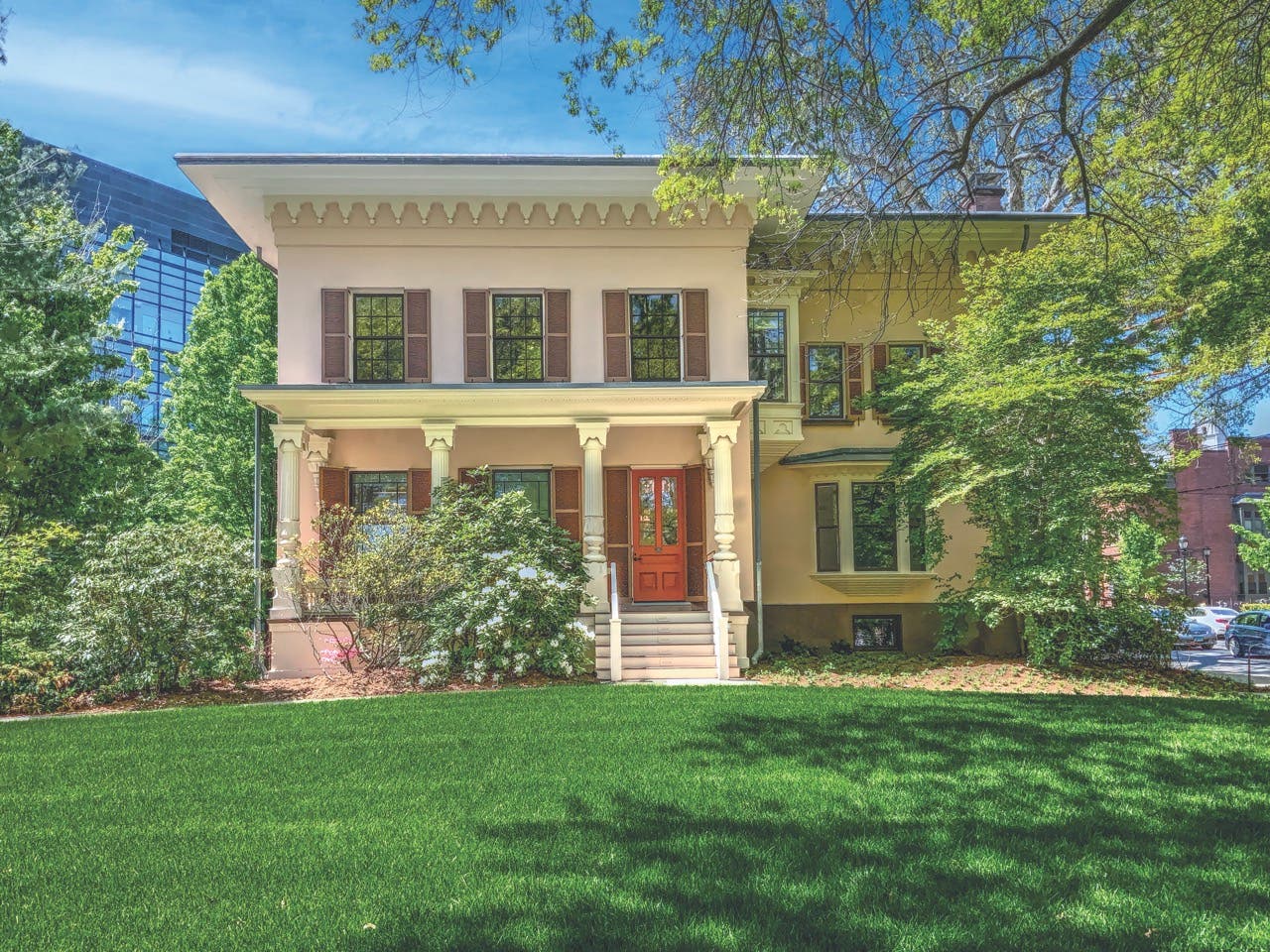
Product Reports
Successful Painting Techniques
Regardless of your role in traditional building, probably every painter you have ever worked with or for has told you that success or failure for any painting job really comes down to good surface preparation. But just what does that really mean?
Charles Gilley, Charles Gilley Restoration Painting, in South Woodstock, Vermont, describes the conditions he needs to paint any substrate confidently: clean, dry, sound, and dull.
Clean
Gilley describes a clean surface as “one that has removed any barrier between the substrate and the coating.” Examples include removing grease in kitchens, body oils from fingerprints and dirt that can accumulate anywhere. Interiors require hand-washing with a mild soap, water, and a good rinse. He avoids pressure washing and uses a garden hose for exteriors. Power washers run the risk of saturating the wood with moisture and that brings us to the next condition to be achieved, dryness.
Dry
A dry wooden substrate should have less than 15 percent moisture content. Gilley prefers not to exceed 12 percent. Duffy Hoffman, of Hoffman Painting and Restoration in Forest Park, Illinois, says that he finds a range of 10 to 15 percent works well with most coatings. Both feel that a moisture meter is an essential tool and the best insurance to confirm whether wood is dry enough to accept paint.
Mario Guertin, of Painting in Partnership, Inc, Palatine, Illinois, notes that a clean and dry surface is just as important for metal substrates. His Chicago-area firm paints many multi-story townhouses with metal cornices and bay and oriel windows from the period of 1880-1920. He worked “on the historical restoration of the façade of one of the three adjacent brownstone houses Potter Palmer had built for his three daughters in the late nineteenth century on Chicago’s Gold Coast area. The project involved the complete rebuilding of the metal two-story bay window, cornice and slate roof elements. All the metal surfaces were faithfully recreated using galvanized steel, that needed high-gloss black paint. The manufacturing process for galvanized steel leaves the surface of the steel coated with a thin oily film. It is essential to remove that oily substance before any primer or coating can be applied. To do the job properly, we used lacquer thinner, scrub pads and rags to clean the metal surfaces. Using a scrub pad really helps to loosen the oily film and rags finish up the job.” Guertin’s blog is full of excellent tips for preservation professionals.
Sound
Soundness usually applies to recoating a surface that has been in service for a while. “There should be nothing loose; in other words, no peeling, lifting or bubbles,” say Gilley. There are many methods of paint removal, and it is best to work with a professional painter for guidance on the best method for the job. Hoffman prefers infrared heaters and a new tool, the Speedheater Cobra available from Eco-Strip, which enables him to do work in small areas or on delicate window details. Gilley really likes the Festool line of tools for paint removal because he needs good, reliable dust collection during paint removal.
Depending on the project, lead-safe work practices may be required. Visit epa.gov for information about Federal laws and State health departments for statutes that may apply in state and local jurisdictions. Anyone working on buildings constructed prior to 1978, should take a Lead RRP course to learn about lead hazards and working safely.
Dull
The surface should be dull or smooth, but it needs what painters call “tooth” according to both Hoffmann and Gilley. This involves putting some profile in the substrate so that the coating bonds or adheres to it.
Other Keys to Success
Gilley cautions that one can’t assume that every coating works in every situation. “Never assume that it does.” You may be working with oil or water-based paints, an acrylic finish, or something with urethane in it. And that brings us to the next bit of critical advice: Read product information materials whether found on the can, technical data from a manufacturer, or in a materials safety data sheet. This might be the fifth step and the second-best bit of insurance beyond the moisture meter to insure a good paint job. Get to know the technical people who work with the manufacturers of the products you use. Ask questions and give them feedback. This is an important step whether you are a painter, contractor, architect, interior designer, facilities manager, or owner. Good technical people want to help you and they benefit from your on-the-jobsite experience. Hoffman stresses that the primer and finish coating should be made by the same manufacturer.
A sixth ingredient in painting success clearly revolves around good communication. Charlie says that the golden rule, “do unto others as you would have done to you” applies on the painting job site just as it does in all areas of life. Since painters are usually the last craft on the job, they are often tasked with cleaning messes and fixing problems left behind by others. He encourages other trades on the job to think about the next trade coming to the project.
Duffy stresses the need for good specifications. He encourages architects and interior designers to work with trusted painters to develop good specifications. He believes the communication process that leads to good specs results in better work.
Mario says to consider the neighborhood, the neighbors, and responsibilities to paint and work safely. “Old buildings in a big city like Chicago are often situated right next or close to the sidewalk and very close to the neighbors. Consequently, gaining access to the surfaces to be worked on can also require the renting of special equipment like a canopy, scaffolding, boom, and the procurement of all the required permits. On a recent paint restoration project, the rental and permit costs alone exceeded $10,000.” He usually works on projects that must comply with RRP standards for lead removal.
Mario Guertin sums it up well, “If you are the owner of such a building, how long would you like the paint job to last? I would say as long as possible! This means that, as a house painting contractor, I must ensure that our surface preparation is as thorough as possible.”
Words of advice for the younger generation thinking about a career in the painting trade
All three of the painters interviewed for this article are committed to their own continuing education and helping others to learn. Charlie Gilley teaches for
the PDCA and the Preservation Education Institute, Historic Windsor, Inc., in Vermont. He encourages young people to seek out trade and vocational education at schools and colleges throughout the US. Mario Guertin encourages those new to the craft to join PDCA and to “surround themselves with talented and experienced professionals” who are willing to teach. Duffy Hoffman
lectures and demonstrates at the Traditional Building Conference and in partnership with many preservation groups throughout the United States as well.
Painting & Decorating Contractors Assoc.
Both Charlie Gilley and Mario Guertin are members of the Painting and Decorating Contractors Association, pdca.org. Each of them has been active in the development of craftsmanship technical training for the nonprofit trade association. The 120-year-old association has over 2,000 professional members and offers podcasts, discussion groups, national and regional training, and peer-to-peer advice. Gilley and Guertin both mention that they give as much as they receive by having a network of peers from whom they can learn and share. Mario mentioned that he shared some concerns he had about a particular technique for some doors on which he was working, and that a fellow PDCA member not only coached him but made a video of the process and sent it to him.
Contact Information
Charles Gilley cbgpainting@gmail.com
Mario Guertin paintpartner.com
Duffy Hoffman sashmasterduffy.com
Judy L. Hayward spends her days pursuing a passion for historic architecture and the ways in which it can be reused to sustain and grow healthy communities. She develops courses in partnership with builders, architects, traditional craftspeople and others to teach both historic preservation and traditional building skills. She has one foot in the nonprofit world as executive director of Historic Windsor and the Preservation Education Institute and the other foot in the world of media and information services as education director for the Traditional Building Conference Series and Online Education Program.








